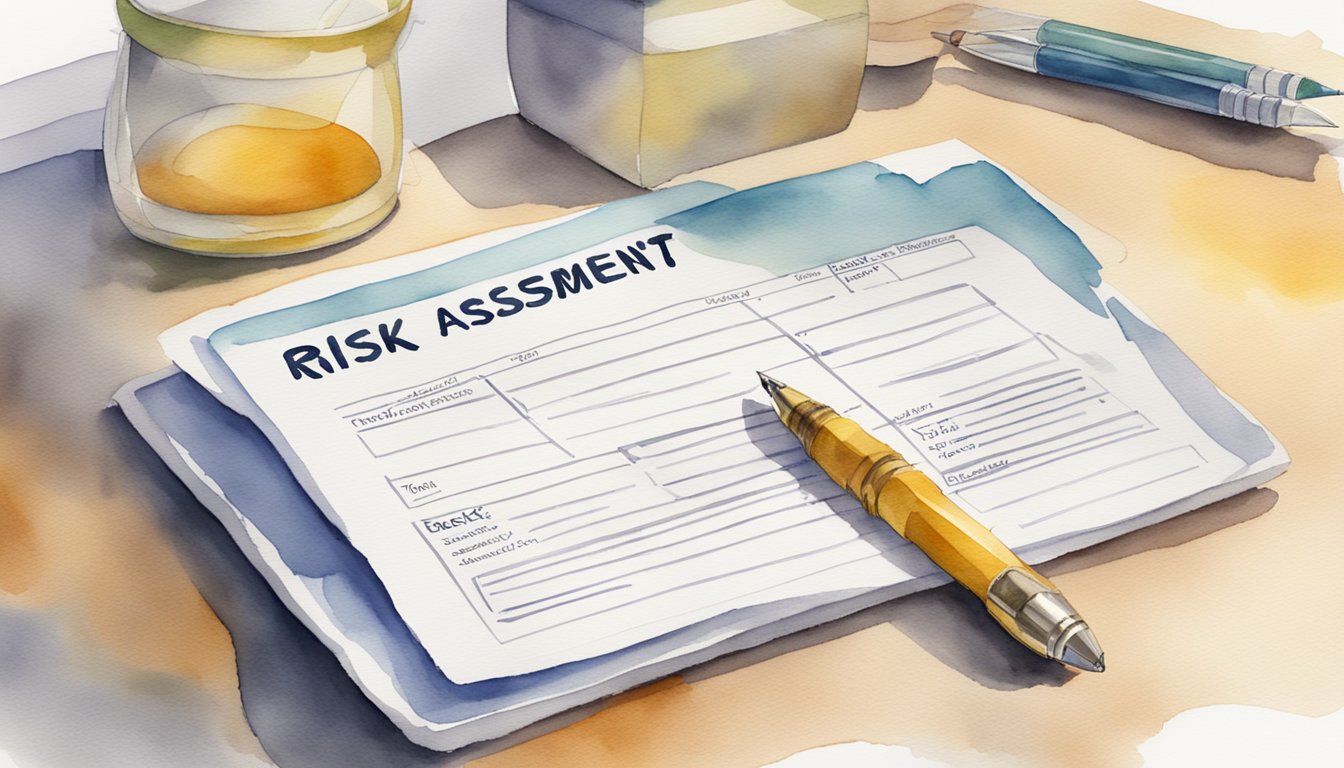Understanding Risk Assessment

In the insurance industry, risk assessment is crucial for identifying and managing potential threats.
It helps in evaluating risks and implementing control measures to protect business objectives and ensure compliance with regulations.
Definition and Risk Management
Risk assessment in insurance involves identifying, evaluating, and prioritizing potential risks.
This process helps you understand the probability of various risks occurring and the potential impact on the organization.
By applying both quantitative and qualitative risk assessment methods, you can analyze data to make informed decisions.
Risk management complements risk assessment by developing strategies to mitigate identified risks. Control measures are essential components of risk management strategies.
They help in reducing or eliminating the impact of risks. Risk assessment tools, such as risk matrices, decision trees, and failure modes and effects analysis (FMEA), are used to analyze and manage risks effectively.
Impact of Risk Assessment on Management Processes
Risk assessment significantly impacts management processes in the insurance industry.
It helps prioritize risks and allocate resources efficiently.
By integrating risk assessment into your management framework, you can enhance decision-making and improve overall business resilience.
Using risk assessment templates allows for standardized evaluation and ensures consistency in the assessment process. Risk evaluation and monitoring activities are critical for ongoing risk control and adaptation to emerging threats.
Implementing an effective risk management strategy ensures continuous improvement and alignment with regulatory requirements.
Regular monitoring and review of risk assessments help you stay updated with changing risk landscapes.
This proactive approach supports business objectives and maintains a robust risk management framework.
Applying Risk Assessment in Practice

Risk assessment in the insurance industry involves identifying and prioritizing potential risks and then taking steps to mitigate or eliminate those hazards.
This helps to protect assets, ensure health and safety, and minimize property damage.
Identifying and Prioritizing Risks
In the insurance industry, identifying risks is crucial to creating effective strategies.
This involves evaluating the workplace, equipment, and other assets for potential hazards.
Regular reviews and inspections help identify these vulnerabilities and threats.
You must categorize risks based on their likelihood and potential impact.
High-priority risks, such as those that could cause significant health and safety issues or property damage, should be addressed first.
Low-priority risks might still need attention but can be scheduled for later review.
Mitigating and Eliminating Hazards
After identifying risks, you must focus on mitigating and eliminating hazards.
This can involve implementing control measures like safety protocols, proper training, and the use of protective gear.
Ensure that resources are allocated to address high-priority risks.
Training employees on safe practices and maintaining equipment regularly can significantly reduce the likelihood of accidents.
Additionally, investing in quality protective gear can prevent injuries, protecting both personnel and company assets.
Effective risk management requires continuous evaluation and adaptation.
Regularly update your strategies to reflect new threats or changes in the workplace, keeping health and safety at the forefront of your operations.
Related Terms and Their Significance

Understanding related terms is crucial when conducting a risk assessment in the insurance industry.
These terms help you navigate through the complexities of assessing and managing potential risks that could impact business operations and compliance.
From Quantitative to Qualitative Assessments
In the insurance industry, assessments can be categorized as quantitative or qualitative. Quantitative assessments involve statistical methods and numerical data to measure potential risks.
This method focuses on calculating the likelihood and impact of risks using tools like a risk matrix to prioritize them.
Qualitative assessments rely on expert opinions and descriptive evaluations.
This approach often includes qualitative risk analysis, which helps identify unknown factors that might affect an insurance company’s reputation or compliance with regulations.
This is essential when evaluating cyber threats and environmental risks, where numerical data may be insufficient.
Aligning Risk Management with Business Goals
Aligning risk management strategies with your company’s business goals ensures seamless operations and targeted risk mitigation.
To achieve this, integrate risk management within your organization’s strategic planning.
This involves documenting potential risks and corresponding mitigation strategies.
For instance, a comprehensive risk assessment enables insurance firms to prioritize investments in cybersecurity, safeguarding sensitive data from breaches.
Aligning risk assessments with business goals also enhances compliance with industry standards and regulations, minimizing legal liabilities.
Use tools like failure modes and effects analysis (FMEA) to evaluate how potential risks could affect different areas of your business, from customer satisfaction to financial stability.
Clear documentation and frequent reviews help align risk management activities with overarching business objectives.
Frequently Asked Questions
To ensure comprehensive risk management, understanding different aspects of risk assessment is essential.
This section covers key questions about risk assessment within the insurance industry.
What are the four elements of a risk assessment?
The four elements of a risk assessment include identifying hazards, evaluating the risks associated with those hazards, determining methods to control those risks, and implementing control measures.
By focusing on these elements, insurers can better predict and mitigate potential losses.
How is risk assessment utilized in a business context?
In the insurance industry, risk assessment helps in determining policy premiums, coverage limits, and exclusions.
Companies evaluate risks such as natural disasters, market volatility, and other financial uncertainties to offer tailored insurance products to their clients.
What are the primary objectives of risk assessment in healthcare settings?
In healthcare, risk assessment aims to identify potential safety hazards, reduce the likelihood of patient harm, and comply with regulatory requirements.
It also assists in determining insurance costs for healthcare providers by assessing the risk factors associated with medical practices and facilities.
Why is risk assessment critical in accounting practices?
Risk assessment in accounting helps identify areas susceptible to financial inaccuracies, fraud, and regulatory non-compliance.
Insurance firms rely on accurate financial statements to determine coverage needs and premiums, making risk assessment in accounting integral to minimizing financial risk.
Can you explain the role of risk assessment in workplace safety?
Workplace safety assessments identify potential hazards that could cause injuries or illnesses.
In the insurance industry, these assessments help in formulating workers’ compensation policies and determining premium rates based on the assessed safety conditions and potential risk factors in a workplace.
How does scientific risk assessment influence policy and regulatory decisions?
Scientific risk assessments provide data-driven insights into potential hazards and their impacts.
In the insurance industry, this information influences the development of coverage policies, underwriting standards, and regulatory compliance.
This ensures that policies are based on accurate risk evaluations and can better protect against unforeseen events.






